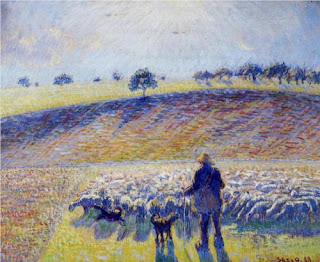 |
| Shepherd and Sheep -- Camille Pisarro (1888) |
The 4th Sunday in Easter is always “Good
Shepherd” Sunday. It gets this name from the fact that the appointed Psalm is
the 23rd – ‘The Lord is my Shepherd’ -- and the Gospel for the day
is a passage from John in which Jesus applies the metaphor of shepherd to
himself. In many churches, it is customary to have “shepherd” hymns and anthems
(often versions of the 23rd Psalm) in order to underline the Good
Shepherd theme.
Partly thanks to the enduring popularity of the 23rd
Psalm, the language of sheep and shepherd is both familiar and comforting to
most church people. And yet, the world in which we live – even in rural areas –
is so far removed from the world in which the biblical shepherd was a familiar
sight that we might wonder whether, despite its familiarity, the image can
still speak to us, or convey anything at all to those who are not already
church goers. Indeed, for a modern audience, describing faithful Christians as
‘sheep’ can be expected to have negative overtones – a docile inability to
think for themselves.
 | ||
| The Good Shepherd |
To make the metaphor speak afresh, we have to understand
that shepherds in biblical times had two crucial tasks. First, they had to lead
the sheep to sources of water that they couldn’t find for themselves. Second,
they had to protect their sheep from wild animals against which they were
powerless. Sheep needed the superior strength, wisdom and care of the shepherd
to survive and flourish. Without it they would “go astray, each to his own way”
as Isaiah famously puts it (Is.56:3).
The message for us is this. However earnest our seeking,
searching, questing and questioning, it is God who finds us, not we who find
God. Our task is to be able to recognize His call, and to follow the divine
Word in preference to establishing paths through life of our own devising.
3rd/4th century mosaic from the Roman Catacomb of Priscilla, courtesy of the Jean and Alexander Heard Library at Vanderbilt Divinity School
No comments:
Post a Comment